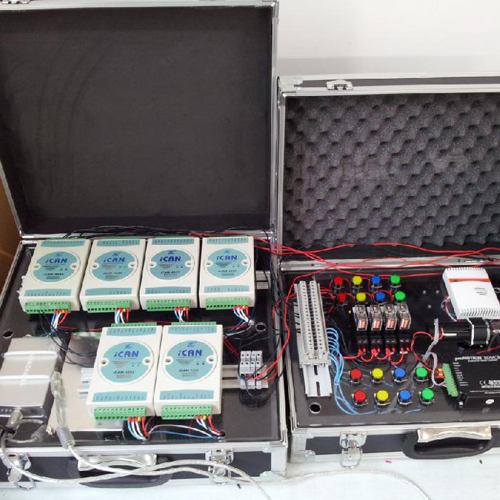[Beijing University of Posts and Telecommunications] CAN bus measurement and control system experiment box

[CAN Bus Measurement and Control System Experiment Box]
Function and Role Introduction
Introduction
I. Overview
The Controller Area Network (CAN) has become a widely used communication protocol due to its high performance, reliability, and unique design. Originally developed by Bosch for automotive applications, CAN has since expanded into various industries such as industrial automation, machinery, robotics, medical devices, and more. Its robustness and real-time capabilities make it ideal for embedded systems and control networks.
For students majoring in automation or related fields, understanding and applying CAN bus technology is essential. The CAN Bus Measurement and Control System Experiment Box provides a hands-on platform that combines both hardware and software learning. It supports practical experiments in courses like Fieldbus Technology, Industrial Automation, and Control Networks. This experiment box is an excellent tool for developing skills in both system design and real-world implementation.
II. Composition of the CAN Bus Measurement and Control System Experiment Box
The experiment box consists of two main components: the iCAN function module box and the target equipment box.
1. The iCAN function module box includes a 24V DC power supply, the USBCAN-2A CAN interface module, and six different iCAN functional modules, such as:
- iCAN4017 – 8-channel A/D module
- iCAN4210 – 2-way D/A module
- iCAN4055 – 8-input/8-output I/O module
- iCAN5502 – 5-way RTD module
- iCAN2404 – 4-way relay output module
- iCAN7202 – 2-way counting/frequency measurement module
One end of the USBCAN-2A connects to the computer via USB, while the other end communicates with the functional modules through the CAN bus.
2. The target equipment box contains terminal blocks, LED indicators, push buttons, relays, a temperature and humidity sensor, and a DC motor with driver. It receives power from the iCAN function module box.
III. Experimental Functions Supported
1. Students gain hands-on experience with actual industrial control components and learn how to apply different modules in real scenarios.
2. They practice connecting signals and power to devices, such as using the iCAN4055 for I/O connections, the iCAN4017 for analog input with a temperature sensor, and the iCAN4210 to control a DC motor’s speed.
3. They learn to configure CAN bus connections, set communication speeds, and assign node addresses to each module.
4. They install drivers for the USBCAN-2A interface module and use the iCANTest software to verify communication and test module functions.
5. Students explore the iCAN master station function library, which simplifies control of the modules by calling basic functions.
6. Using programming languages like Visual C++ or VB, they develop their own measurement and control systems and interfaces.
IV. Application Advantages
1. The experiment box is designed based on real engineering projects, offering a microcosm of actual industrial systems.
2. It includes genuine industrial control modules that cover most common signal types found in real-world applications.
3. It helps students improve both hardware connection skills and software development abilities, serving as a comprehensive platform for learning and innovation.
4. Compact and portable, it takes up little lab space and enhances laboratory efficiency.
Name of the Work: CAN Bus Measurement and Control System Experiment Box
Completed by: School of Automation, Beijing University of Posts and Telecommunications
Mid-Century Modern Side Tables
INCHEE FURNITURE CO.,LTD , https://www.inchee.com